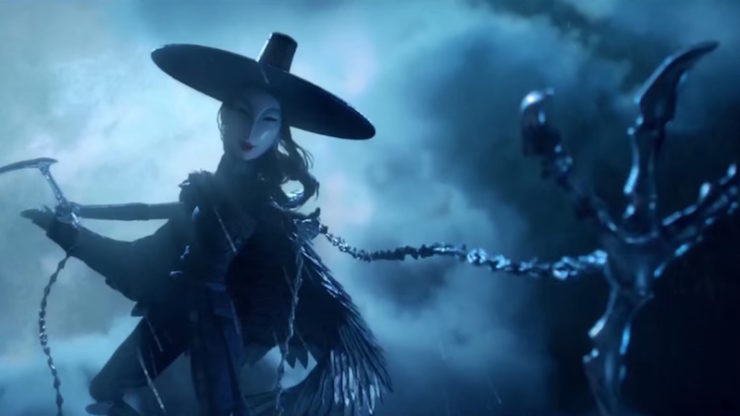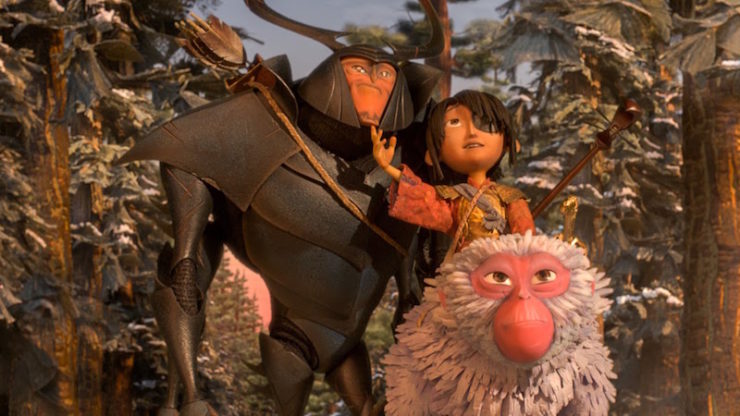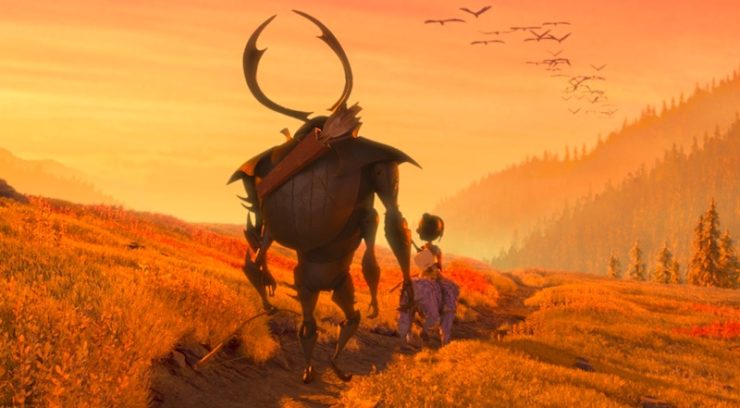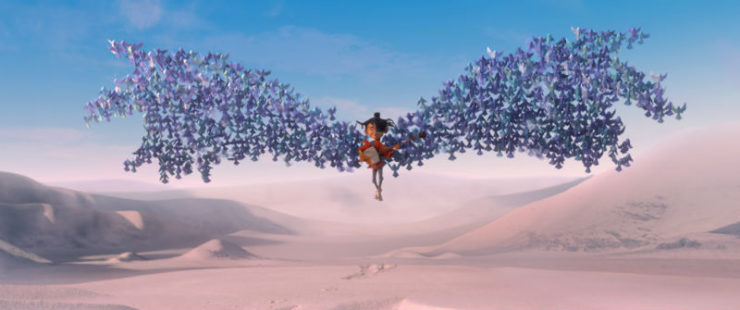Kubo and The Two Strings is an extraordinary film that marries complex themes with some of the most beautiful animation I’ve ever seen. Please be warned, this review will turn into a discussion and get into spoiler territory in a few paragraphs, so I’ll start with my condensed review, in case you’re still on the fence:
GO SEE IT. Go see it as soon as you can, because it’s a beautiful film, it uses a singular combination of origami and stop motion to tell its story. It’s the best Laika production since Coraline, and it’s telling a vital story about stories, human identity, and death. (Why is everything about death lately? The people running the simulation we’re all in are getting really repetitive. We should complain to someone.)
The basic plot, without spoiling anything, is that Kubo, the young protagonist, must go on a quest to retrieve some magical items and defend his home from the evil Moon King. This quest is the skeleton for a much deeper plot, which goes in a few unexpected directions before coming to an ending that I was hoping for but not expecting. While the story is original, it’s set in a fantasy Japan, and references Japanese folklore, Buddhism, and samurai code.
Now, the other thing I’ll say, for the benefit of the parents in the audience, is that this is an intense film. At my showing (8:00pm on the Upper East Side of Manhattan) there were a lot of families with small kids, some adults, and some clumps of teens who seemed to be there to appreciate the animation. Of those, I saw only one family get up and flee, about ten minutes into the film, because it was clearly too much for the smaller child (I’d put him at about 6). There was also a second child who cried loudly at one point, but then stuck it out and seemed to really love the film as the credits were rolling. So, parents, keep in mind that there is some real violence, swordfighting, wounds that bleed, and real, permanent loss. This is a film that sets out to confront death and change, and it doesn’t blink. (The film it reminded me of most was The Neverending Story—not exactly a recent animated movie—which I was fine with when I was 7…. but I also actively liked Poltergeist.) So please keep that in mind when deciding if it’s OK for your children.
So, from here, spoilers!

The quest is spectacular. Kubo is joined by a monkey charm that turns into a real monkey, and later by a human who’s been cursed to live as a beetle. The child’s storytelling and origami magic are integral to the journey, and we see him grow stronger in magic over the journey. There are exciting set piece adventures and battles, and everyone learns to love and depend on each other. Where Kubo and The Two Strings sets itself apart is in the filmmakers’ decision to let the film get serious. They aren’t afraid to establish a world that is both beautiful and bleak, with real, terrible consequences side-by-side with joy and hope. They give weight to the fun adventure portion of the film, but when there’s a fight, there is blood, and when there is death, they don’t look away from it.
The animation is breathtaking. The combination of stop motion with origami gives the worlds texture that I’ve never seen in a full-length animated film before. Best of all, however, is that the choice of animation works for the film! The reliance on paper and origami magic underscores the idea that Kubo’s world is literally made of stories. Plus, rather than using the written word, his use of origami and music can be understood by anyone of any age, language, or culture.
The sidekicks, Monkey and Beetle, fall into a well-worn comedy duo, with Monkey being all business, focused on the quest and its dangers. Beetle, with his lapses of memory and cheerful demeanor, starts as comic relief, and the pair’s initial interactions are light. But the film makes a point of deepening both characters, darkening their story, until they’re at least as important as Kubo himself. The Moon King is a distant villain, but once he appears, he fully justifies Kubo’s fear of him. Best of all are Kubo’s aunts, a pair of witches both voiced by Rooney Mara in a fantastic echoing trill that reminded me of the title character in The Bride with White Hair.

Speaking of that… if Kubo has a real flaw, it’s that it’s a pastiche of the heroic quests that came before it, but then it would be hard to avoid at least some references. The most obvious, as I mentioned, is The Neverending Story—the characters even walk through a piece of graffiti that depicts the quest they’ve just been on, as Atreyu does when he faces Gmork—but this seems entirely appropriate, since both films are stories within stories that play with mythical tropes as much as they follow them. The story also bounces off Jonah (the one with the whale), Hayao Miyazaki’s oeuvre, and Rurouni Kenshin.
Which leads to the other flaw, which I’m going to tap dance around a little. I think I understand why Laika chose to tell a story set in a Japanese milieu (more on that below), but it was frustrating that the main characters are voiced by white actors. Those performances are all fantastic, but Japanese actors including George Takei and Cary-Hiroyuki Tagawa voice smaller roles. I’m assuming that this is because the studio wanted to put as many Western marquee names on the film as possible to attract audiences, but this tradition of whitewashing really needs to die already. And stay dead, not just come back transformed in some new shape.
The meaning of “The Two Strings” changes over the course of the film. They are the literal strings on Kubo’s shamisen, but they’re also Kubo’s mother and father; Monkey and Beetle; life and death; storytelling and violence; and, most of all, creativity and destruction. The creative act of storytelling is held up against the destructive act of using violence against the Moon King. I would argue that two of the strings are also Buddhism and the older pantheon of nature gods represented by the Moon King. (Please note that the Moon King is an original creation of the film’s: In Shinto, the Moon God is Tsukuyomi.) While the Moon King wants to emphasize a hierarchy in which the immortals exist in constant unchanging bliss, those stuck in the morass of Earthly life must embrace that life is change, that pain is inevitable, that death is transformation, but that beauty and peace also exist, and a good enough story can make life not just bearable but wonderful. (I’m not suggesting here that the film is preaching Buddhism, simply that the contrast between these two Japanese traditions is explored.)
As I said earlier, I wondered going into the film why Laika, a Western animation studio, chose to tell a story with Japanese characters, and I think this tension between philosophies could be the key. Kubo has to face death in a way that could only work against a backdrop of Buddhism, Hinduism, or Shinto. The monolith of monotheism, with its hard stop of judgment and afterlife, would undermine the main theme of the story. Instead we get the fluidity of a Buddhist Oban Festival, in which the spirits of the dead come back to visit their loved ones. We get stories of cranes guiding souls to the afterlife, passing easily between worlds. Most of all, we get the idea that loss can be a good thing, no matter how much it hurts.

However the loss that death brings is only the most obvious way that the film explores this theme. Kubo’s grandfather, the Moon King, took one of his eyes, which has literally changed Kubo’s perspective, and forced him to grow up compensating for it. The driving plot is that the Moon King wants his other eye. This is grim stuff, but as we learn, from his grandfather’s perspective, taking Kubo’s eyes would be a gift. Kubo’s father sacrificed himself protecting Kubo and his mother. Kubo and his mother’s life together is shaped by this loss. Kubo’s mother suffers a nebulous dementia that seems to leave her catatonic as long as the sun is up, but lets her snap back into consciousness for a few hours at night. Kubo cares for her, earning money by storytelling in the village, while she tells him stories during her few hours of lucidity. We don’t know if this memory loss is post-traumatic stress from escaping with Kubo, or if it’s a magical curse. We only know what Kubo knows. He is the only one left to care for his mother, his grandfather and aunts are dangerous, and he must be home each night before sunset to avoid the watchful eyes of the Moon King. It’s his failure to come home one night—his forgetfulness—that kickstarts his quest, leading to the loss of the last vestiges of his mother’s protection and his childhood. When Kubo meets Beetle, he learns that he was once a man, but that even worse than being cursed to live as a beetle is the fact that his enemy also erased his memories of his past life, and left him with the constant loss of short-term events. When Kubo’s mother fights her sisters, they make it clear that they hate her because they lost her to Kubo’s father. Each loss is seen as traumatic. The film gives each fresh change the weight it deserves. But it also emphasizes the idea that loss can be dealt with, lived through, and even lead to a new and better understanding of life.
At its heart, Kubo and the Two Strings believes that all of us have the power to tell our own story. The theme resounds through the whole film, but never so much that it feels preachy or overwhelming. When his mother tells Kubo the true story of how she met his father, we learn that she was supposed to kill him. Instead, she changes the story partway through their fight when she allows herself to love him. Rather than giving up in despair, Kubo continues to tell his own story as a hero on a quest. Finally, the tales that Kubo spins in the village are always about vengeance and the clash of mighty warriors, but when he comes to the end of his own story, he realizes that compassion will give him a better ending.
I wrote two years ago about the ways I think the hero’s quest has itself changed. For centuries the purpose of these stories was to glorify battle and to inspire children to become warriors and the mothers of warriors. Over the last hundred years, it seems like people are finally, finally, trying to tell stories of epic quests that don’t unthinkingly follow a warrior’s path, but rather teach their young heroes to solve conflicts through compassion and creativity. Kubo and The Two Strings follows that trend by making the ability to tell a good story the greatest weapon anyone can have.
If you meet Leah Schnelbach in the street, kill her. Er, wait, scratch that, she got carried away… just come talk to her on Twitter!










